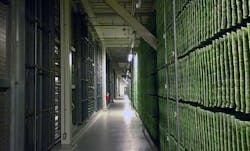From PUE to ‘GUE’ – Measuring the Continued Evolution of Data Center Sustainability
Sean Farney, Director of Data Center Marketing, Kohler Power Systems, highlights the need for an all-encompassing and standardized way to measure and report on data center sustainability across the entire data center ecosystem.
Sean Farney, Director of Data Center Marketing, Kohler Power Systems
In The Power of the Negawatt: Efficiency Improves Data Centers’ Energy Impact, Rich Miller recently gave the data center industry some long overdue credit for bending the power consumption curve down while significantly expanding server fleet size over the last 10 years.
Led from the front by the GAFAM Hyperscalers, we warmly embraced (Power Usage Effectiveness) as a measurement tool and, subsequently, gamified it amongst peer companies in an asymptotic race to 1.0.
While at Microsoft, at the behest of luminaries Mike Manos and Christian Belady (PUE’s primogenitor), I led a very talented team in bringing the first large-scale (120MW) Container data center online. By thinking creatively- putting servers in a box to more efficiently manage air flow- we achieved industry-leading PUE of 1.2. Not necessarily revolutionary; data center managers had been constructing all manner of contraptions to steer hot air in raised floor environments. But evolutionary to the extent that tetrapods transitioning from water to land was; kind of a big change. Not only did we drop OpEx 30%, but we advanced sustainability substantially by consuming less energy. From the Green Grid to the Wholesale building frenzy that ensued, this ethos spread across the entire industry, leading to a culture of PUE-guided sensibility.
As parallel in broader industry, I point to the success that Ford has had with their EcoBoost engine platform. By sizing the engine for median power output, but turbo charging it for brief periods of peak output- extremely evolutionary, but not revolutionary thinking- Ford has engineered 30% better fuel economy and 15% less greenhouse emissions. And as a customer, I’m delighted that my F-150’s “little” V6 puts out 450 horsepower yet gets 20 miles to the gallon, meaning fewer outings to Kwik Trip.
It’s useful to use this context when thinking about the next chapter in data center sustainability measurement. PUE hasn’t become passe, but thanks to increased measurement capabilities across the entire data center sustainability value chain, it now feels unidimensional. As an example, I recently saw an advert from NTT Data Centers that included a facility-specific breakdown of utility power generation source- gas, solar, wind, nuclear, coal, etc. This granularity is both impressive and a strong demand signal for multivariate measurement.
We really do have a great story to tell about our sustainability evolution in the space and shouldn’t waste the opportunity!
EPA Certified Tier 4 Final generator (Image: Courtesy of Kohler)
Similarly, diesel generator manufacturers have been engineering hard since 2014 to meet the U.S. EPA emissions requirements referred to as ‘Tier 4’ . Between aftermarket treatment technologies and enclosure systems, pollutant emissions have been drastically curtailed in the last ten years. The abatement systems employed also give operators the ability to measure and trumpet these advances. At Kohler, we are on the front-lines of this battle against emitted pollutants and are proud to provide factory-direct Tier 4 packaged units.
Given the increasing intensity of sustainability optics and the volumes of analytics we now have at our disposal, we really need a new measurement spec. I’ll playfully coin the moniker GUE- Green Usage Effectiveness (pausing for eyeroll) as simply a placeholder to express the need for an all-encompassing and standardized way to measure and report on the sustainability across the entire data center ecosystem. Answering the inevitable and immediate hue and cry, I say “we did this before”— think Uptime Institute Tier Classifications. It was a similar challenge, albeit with a design & engineering answer, but the industry agreed to common language and parameters to drive standardized outcomes. Just a thought, but one perhaps industry leadership should investigate. We really do have a great story to tell about our sustainability evolution in the space and shouldn’t waste the opportunity!
Sean Farney is the Director of Data Center Marketing at Kohler Power Systems.


